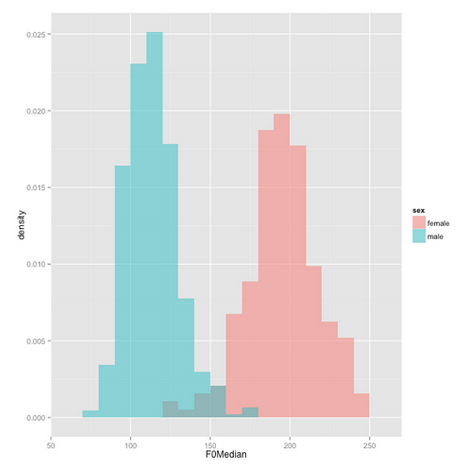There are many linguistic features that contribute to one’s gender identity (and the perception thereof). This post about pitch is the first in a three-part series of blog posts about what makes men and women sound different.
I have previously written on this blog about the myths surrounding women’s language, encouraging readers to be skeptical of claims that men and women “speak different languages,” that women talk more than men, or that women are naturally better communicators than men. The way that men and women speak is in fact very similar.
So if men and women speak similarly, why do they sound different? If, for example, you get a call from a telemarketer, you can generally figure out the gender identity of the telemarketer without too much trouble. The main question for linguists (and others) who study gender is the following: which of these small but perceptible differences are biological, and which are social?
One of the first and most obviously biological differences between men and women’s speech is pitch. In one of his “Breakfast Experiments” for Language Log, Mark Liberman calculated the median pitch from two sentences read by 192 female and 438 male speakers, all native speakers of American English. In the chart below, the x axis represents median pitch in Hertz (frequency), and the y axis represents the proportion of speakers whose median frequency corresponds to that pitch. Most women (pink) have higher voices than men (blue). This is partially because men are normally larger than women (biologists call this sexual dimorphism), which means their vocal folds are larger. Thus, men have lower pitched voices — much like a violin is smaller and higher-pitched than a cello, even though structurally they are very similar.
These differences in pitch seem easy to explain based on sexual dimorphism , but in reality the picture is more complicated than that. There are several studies which indicate that pitch isn’t just about size. For example, a 1975 study found that pre-pubescent children have exhibited differences in pitch, even though their bodies are not very different in size because they haven’t gone through puberty yet. This finding indicates that children alter their pitch to imitate the adults around them, and fulfill the social expectation that boys have lower-pitched voices than girls of the same age, regardless of the biological facts of vocal fold size.
There are also many cross-cultural differences in pitch between speaker groups of the same gender. While it is the case in all documented cultures that male speakers usually have lower pitches than female speakers, there can be some surprising differences. For instance, the average pitch for a male speaker of English is 130 Hz, whereas male Swedish speakers have an average pitch more than 20 Hz lower (see table below). A 1995 study by Renee van Bezooijen found that Dutch women’s pitch was significantly lower than Japanese women’s. van Bezooijen hypothesized that women in Japan, with its strict gender roles for men and women, were expected to have higher-pitched voices in order to sound more feminine. van Bezooijen claimed that the Dutch women felt no such need because their culture is more egalitarian when it comes to gender roles.
From lecture slides from Dr. Rob Podesva, Stanford University
These findings indicate that what starts off as a biological difference from sexual dimorphism can be exaggerated based on social expectations. These social expectations are part of a concept known as gender performativity. Gender performativity is a term coined by Judith Butler, who theorizes that gender identity is bolstered by a continuous performance of individual acts. For instance, a woman may perform her gender by wearing a dress or wearing makeup. Certain aspects of speech are also symbolic of gender, and like clothing, these aspects change based on culture.
Pitch is one of these aspects. While pitch is a major factor in linguistic gender identity, it is not the only one. In the next installment of this special three-part series, I’ll talk about some other features that are different in the speech of men and women.



